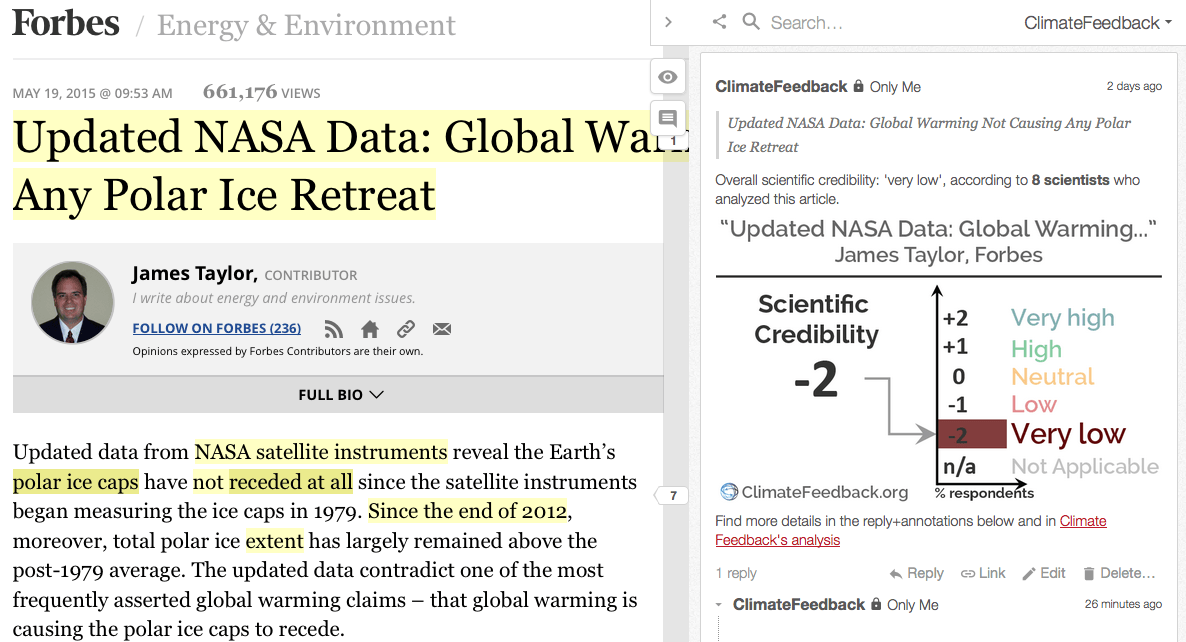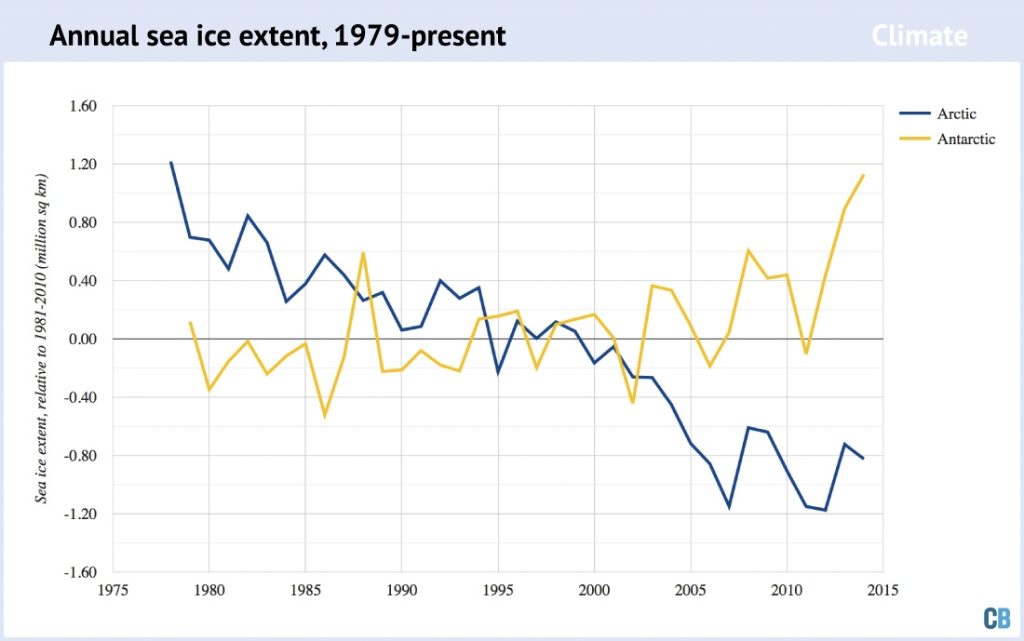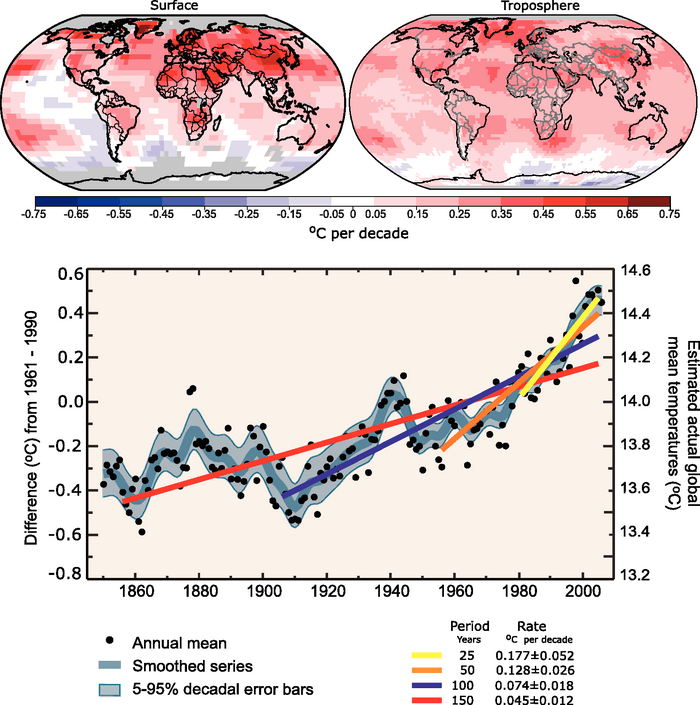Eight scientists analyzed the article and estimated that its overall scientific credibility was 'very low'. more about the credibility rating
A majority of reviewers tagged the article as: Biased, Cherry picking, Flawed reasoning, Inaccurate, Misleading.

SCIENTISTS‘ FEEDBACK
SUMMARY
This article has been read more than 660,000 times since it was published in May, making it Forbes’s most read article on climate in 2015. So how accurate was it?
Not accurate at all. According to the reviewers, this article contains numerous factual errors and flawed logic. The author fails to distinguish between sea and land ice, and the Arctic and Antarctic. Taylor’s conclusion, which contradicts the observed signal of global warming on polar ice, is misleading.
See all the scientists’ annotations in context
If the link does not work due to the high number of ads on Forbes, install Hypothesis bookmarklet or extension in your browser and switch it on from the article page.
UPDATE (6 September 2019): On an unspecified date, Forbes retracted this post. A note on the article now reads: „After review, this post has been removed for failing to meet our editorial standards. We are providing our readers the headline, author and first paragraphs for context only. We regret any inconvenience or confusion.“
GUEST COMMENTS
Jennifer Francis, Research Professor I, Department of Marine and Coastal Sciences, Rutgers University
As is clearly explained in a recent article from Carbon Brief, sea ice behavior in the Arctic and Antarctic is responding to climate change in different ways, and we know why.
In the graph below, it is obvious that Arctic sea ice is disappearing at a much faster rate than Antarctic ice is increasing. Numerous studies have concluded that Arctic ice loss results from a combination of thinning due to greenhouse-gas warming, natural events that flushed thick ice out of the region, and various positive feedbacks (amplifying effects) that augment the ice loss. Climate models cannot reproduce observed Arctic sea ice loss without including the buildup of greenhouse gases in the atmosphere. On this topic the science is settled.
In Antarctica, sea ice varies from year to year much more than it does in the Arctic because its boundaries are not confined by land, as they are in the Arctic. The Southern Ocean sea ice is free to move with the ferocious winds and strong ocean currents that prevail there and cause the large variations. In recent years, the amount of sea ice in winter (when it has a relatively small effect on the global energy balance because there’s no sunlight) has increased, but much less than the amount lost in the Arctic. This increase has been caused by stronger storms (related to a recovering ozone hole) and fresher surface waters (owing to melting of Antarctica’s ice shelves). Because the Antarctic is so much colder than the Arctic, it takes a much larger temperature increase to affect the sea ice, but eventually global warming will cause this sea ice to decline, as well.
Readers of articles such as this that claim to refute decades of peer-reviewed science must arm themselves with a healthy dose of skepticism — the good kind. Dig deeper, inform yourself, and don’t take one non-scientist’s take as gospel just because it supports a position that you hope is true.
 Arctic and Antarctic annual average sea ice extent (million square kilometres), from 1979 to present, against a baseline of 1981-2010. Source: Monthly data available from NOAA, via the NSIDC.
Arctic and Antarctic annual average sea ice extent (million square kilometres), from 1979 to present, against a baseline of 1981-2010. Source: Monthly data available from NOAA, via the NSIDC.
Julienne Stroeve , Senior Research Scientist, National Snow and Ice Data Center
The article is misleading and completely incorrect. It appears that the article is lumping together sea ice and ice sheets, although perhaps the author does not know the difference between sea ice and the ice on Greenland and Antarctica.
Several outright false statements persist in the article:
1) Sea ice from earlier satellites, submarines, aircraft, whaling log reports, etc. do not show that polar ice caps were more extensive in 1979 than the 1920s. Sea ice also did not remain at 1979 levels until 2005. There is no NASA data that shows this. Arctic sea ice has been declining in all calendar months and in all regions of the Arctic (except for slight increase in the Bering Sea during winter) since the satellite record began, it has not recovered in any way. The Antarctic shows areas of small regional increases that are dependent on the time of year, but in contrast to the Arctic, these increases are not for all sea ice regions and they do not happen in all calendar months.
2) The author also appears confused by the fact that the sea ice grows back every winter and fails to understand the importance of weather. We do not expect each year to exhibit lower sea ice extents than the year before as sea ice responds to the weather patterns, and a particularly cold year may help keep ice around in one summer (such as in 2013). That does not imply the long-term trend is not continuing, just that there are departures from year to year along the long-term trend. Just as one shouldn’t make a big deal out of the record low in 2012, they shouldn’t point to 2013 as a recovery. 2015 shows this to be very true despite the author’s claim of a „dramatic rebound“ in 2013, and the false statement that sea ice has been 5% above the 1979 average ever since 2012.
3) May 2015 does not show sea ice 5% above the 1979 average, in fact the Arctic set an all time record low for the winter maximum in 2015. And while the Antarctic had some record high summer ice, the maximum in 2015 was near average.
4) There is no definition of what the author means by land ice, but records show increased melting of Greenland and parts of Antarctica, that together lead to significant increases in global sea level.
REVIEWERS’ OVERALL FEEDBACK
These comments are the overall opinion of scientists on the article, they are substantiated by their knowledge in the field and by the content of the analysis in the annotations on the article.
Twila Moon, Research Scientist, University of Colorado, Boulder:
This article was overwhelmingly misleading. The author consistently applied incorrect methods to come to false conclusions using real data. Terms were also used incorrectly, increasing confusion.
Ken Mankoff, Senior Scientist, Geological Survey of Denmark & Greenland:
This article discusses land and sea ice interchangebly and appears to confuse the two. This is a fundamental error, equivalent in other fields to confusing house and senate, or an artery and vein.
Ron Kwok, Senior Research Scientist, Jet Propulsion Laboratory, California Institute of Technology:
In this article, The Arctic and Antarctic ice cover are totally muddled.
Most of the trends quoted are of the Arctic, even though the mechanisms controlling Arctic and Antarctic ice differ and should be considered carefully and separately.
Robert Grumbine, Physical Scientist, National Oceanic and Atmospheric Administration:
Cherry picking, misrepresentation, distortion. Substituting personal value judgements for scientific conclusions.
Ilissa Ocko, Climate Scientist, Environmental Defense Fund:
The author asserts bold statements that are not whatsoever backed up by science and scientific research. The article is misleading and flat out incorrect, with flawed reasoning throughout.
Jan Lenaerts, Assistant Professor, University of Colorado, Boulder:
This article claims that global sea ice has not decreased since 2012, by ‚cherry-picking‘ data comparing short term signal to a long-term trend. It contains many invalid and unjustified claims.
Rasmus Benestad, Senior scientist, The Norwegian Meteorological institute:
The article contains a number of inaccuracies and mixes up different aspects. The sea-ice reduction in the Arctic is a summer-time phenomenon, whereas the Antarctic sea-ice is a winter-time condition. Thus, the sea ice at the two poles involve different mechansisms, in addition to playing out in different geography (the North pole is an ocean basin surrounded by land, whereas the South pole is land surrounded by sea). It’s very naive to think that ice is just ice.
Notes:
[1] See the rating guidelines used for article evaluations.
[2] Each evaluation is independent. Scientists‘ comments are all published at the same time.
KEY TAKE-AWAY
The statements quoted below are from James Taylor; comments and replies are from the reviewers.
„Updated data from NASA satellite instruments reveal the Earth’s polar ice caps have not receded at all since the satellite instruments began measuring the ice caps in 1979.“
Dr. Robert Grumbine, National Oceanic and Atmospheric Administration:
Incorrect on at least two levels. What he compares is ice at a particular time in 1979 with ice at a particular time in 2015. Today (23 October 2015), the figure is negative; ice is again below the long term average, and below values at any time in 1979.
The second and more important level on which this is wrong is that for examining long term trends, scientists use all the data, not just two particular days out of 36 (and growing) years of data. The long term trend is negative.
Both of these can be verified by going to Cryosphere Today, at the University of Illinois.
See also Cryosphere Today’s response to this article.
Twila Moon, Research Scientist, University of Colorado, Boulder:This is flat out false. NASA has an excellent visualization and graph of Arctic sea ice decline since 1979. Antarctic sea ice, on the other hand, has had some expansion. However, this expansion does not negate climate change, as explained in this news article.
„Since the end of 2012, moreover, total polar ice extent has largely remained above the post-1979 average.“
Ken Mankoff, Senior Scientist, Geological Survey of Denmark & Greenland:
Extent is a measure of area, but volume also matters. The short-term area increase is due to new thin ice. This ice melts more easily than the older thicker ice which used to occupy this area.
See this news article.
„The late 1970s marked the end of a 30-year cooling trend.“
Ken Mankoff, Senior Scientist, Geological Survey of Denmark & Greenland:
Also misleading. Natural variability is still part of the ongoing climate warming. While the late 1970s were cooler than the years around 1904, it was not a continuous cooling, as seen below. You can also see in this figure that late 1970s temperatures were still high in comparison to the previous 120 years.

„As a result, the polar ice caps were quite likely more extensive than they had been since at least the 1920s.“
Dr. Robert Grumbine, National Oceanic and Atmospheric Administration:
Mr. Taylor should publish his research on what the sea ice area was. Otherwise, he is simply stating his opinion on a technical topic. And he his not an expert in this topic.
„Beginning in 2005, however, polar ice modestly receded for several years.“
Dr. Robert Grumbine, National Oceanic and Atmospheric Administration:
Mr. Taylor’s value judgement of ‚modest‘ recession is, again, hampered by not being expert in sea ice. A ‚modest‘ change in body temperature from 98.6 F to 108.6 F (only 10 degrees, the outside temperature changes by 30 degrees some days) would be fatal. ‚Modest‘ is decided by examining the thing you’re studying.
„Total polar ice area—factoring in both sea and land ice—had receded by much less than 10 percent, but alarmists focused on the sea ice loss as ‚proof‘ of a global warming crisis.“
Ilissa Ocko, Climate Scientist, Environmental Defense Fund:
Lumping all of the polar ice together is not very insightful.
First – land ice and sea ice are very different; land ice accumulates for thousands of years while sea ice is a seasonal and inter-annual process. Land ice in Antarctica is melting rapidly which means that water stored for centuries is entering the oceans raising sea level. However, sea ice in Antarctica is slightly gaining likely because of mixing processes between melting freshwater and ocean saltwater. The sea ice in Antarctica has little impact on the energy balance and does not change sea level. One must distinguish between the two different processes of land and sea ice.
Second – Arctic and Antarctic processes are very different. The Antarctic is much cooler than the Arctic, as it is very isolated from the rest of the world with a current that prevents some of the warming from reaching the area. Even though the Antarctic air and sea are warming, because the Antarctic sea ice melts every summer anyways, and the Arctic’s does not, Arctic sea ice melt strongly impacts the energy balance. Sea ice volume in the Arctic has decreased by 50% from 1979 to today – data from the Polar Science Center.
Third – polar ice area is not nearly as telling as polar ice mass or volume, so the metric that the author uses is extremely misleading.
„receding polar ice caps have little if any negative impact on human health and welfare, and likely a positive benefit“
Ilissa Ocko, Climate Scientist, Environmental Defense Fund:
This is not true.
Polar ice caps (land ice) have already contributed to sea level rise that has impacted coastal communities all over the world. Currently, mean sea level rise (7.5 inches globally; 1 foot off the Northeast U.S.) manifests its worst impacts through storm surges that are much higher than they would otherwise be. …
Further, Arctic communities have already been impacted by melting ice and permafrost. One resident of an Eskimo community stated in 2012 that “Not that long ago the water was far from our village and could not be easily seen from our homes. Today the weather is changing and is slowly taking away our village. Our boardwalks are warped, some of our buildings tilt, the land is sinking and falling away, and the water is close to our homes. The infrastructure that supports our village is compromised and affecting the health and well-being of our community members, especially our children.” Coastal erosion has threatened many communities, and standard defensive adaptation strategies, such as rock walls, sandbags, and riprap, have been unsuccessful. High costs to relocate have prevented all but one Alaskan village to escape.

